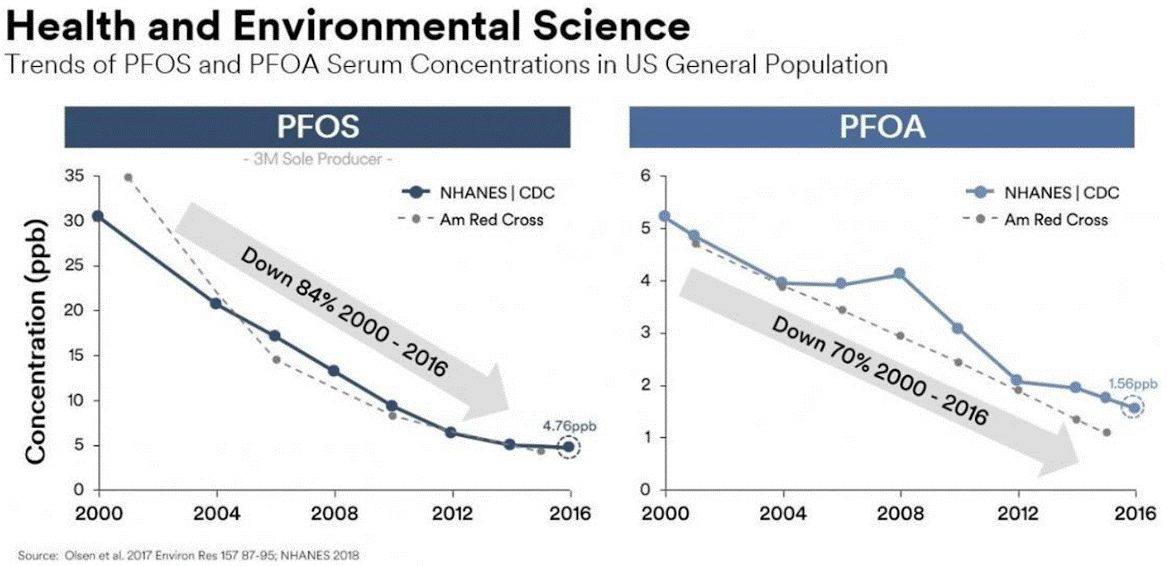Per- and Polyfluoroalkyl Substances (PFAS)
What is PFAS?
PFAS are widely used synthetic chemicals that have been manufactured by a broad range of industries since the 1940s. PFAS are used in products such as cleaning products, water-resistant fabrics, grease-resistant paper, nonstick cookware, personal care products (ie. shampoo, dental floss, nail polish, eye makeup), stain-resistance coatings (carpet, upholstery and other fabrics), fire fighting foam and others. PFAS are long lasting chemicals, because their components break down very slowly over time.
Because of their widespread use and their persistence in the environment, many PFAS are found in the blood of people and animals all over the world and are present at low levels in a variety of food products and in the environment. PFAS are found in water, air, fish and soil across the nation and the globe. Some of the most harmful PFAS have been largely phased out due to health and environmental concerns. However, there are thousands of PFAS, and they are still found in use.
Why are we concerned about PFAS?
Exposure to PFAS chemicals is a concern if you are exposed to them over a long period of time – such as 70 years, which was used by EPA in setting their MCLs. In addition, PFAS can cause health concerns in critical life stages, such as pregnancy or early childhood.
Is PFAS regulated in drinking water?
On April 10, 2024, EPA announced the final National Primary Drinking Water Regulation (NPDWR) for six PFAS (https://www.epa.gov/sdwa/and-polyfluoroalkyl-substances-pfas). The new rule requires public water systems to monitor for these PFAS and have three years to complete initial monitoring (by 2027), followed by ongoing compliance monitoring. Public water systems have five years (by 2029) to implement solutions that reduce PFAS, if monitoring shows that drinking water levels exceed the maximum contaminant levels (MCLs).
What is Johnston County doing about potential PFAS in drinking water?
The County does not use PFAS in our water treatment process. Any PFAS chemicals in our finished drinking water come from our source water. The County has proactively conducted recent testing to determine PFAS levels in the County’s water supply and finished water. Summary test results are as follows:

Table Notes:
All parameters reported in parts per trillion (ppt)
ND – Non Detect
**Hazard Index (Unitless)
The County has engaged a consultant who has been at the forefront of PFAS treatment over the last ten years to further evaluate PFAS levels in the County’s water supply, implement a pilot study and recommend treatment improvements to minimize PFAS levels and ensure levels remain below the MCLs identified by EPA.
We will continue to update our customers regarding PFAS and any other drinking water issues. In the meantime, you can find additional information and FAQs from EPA at https://www.epa.gov/pfas.
What is Johnston County doing about potential PFAS in the source water (Neuse River)?
The County is unaware of any immediate upstream industrial discharges with potential PFAS contamination. The County is currently part of two class action settlements (3M Company and Dupont/Chemours Company related to industrial PFAS contamination. Any settlement compensation received by the County will aid in funding additional treatment improvements to remove PFAS from the County’s water supply.
Additional Information Regarding PFAS Trends in the United States
The government has tracked PFAS levels in our blood for several decades, and that testing reveals dramatic reductions in the PFAS levels in our bodies (see below). In general, our exposure to these chemicals has never been lower.
We would anticipate PFAS levels to further decrease in our bodies and the environment due to the focus on these chemicals and commitments by producers, such as 3M, to cease production of these chemicals.

Quick Links
Page last updated: May 22, 2025
